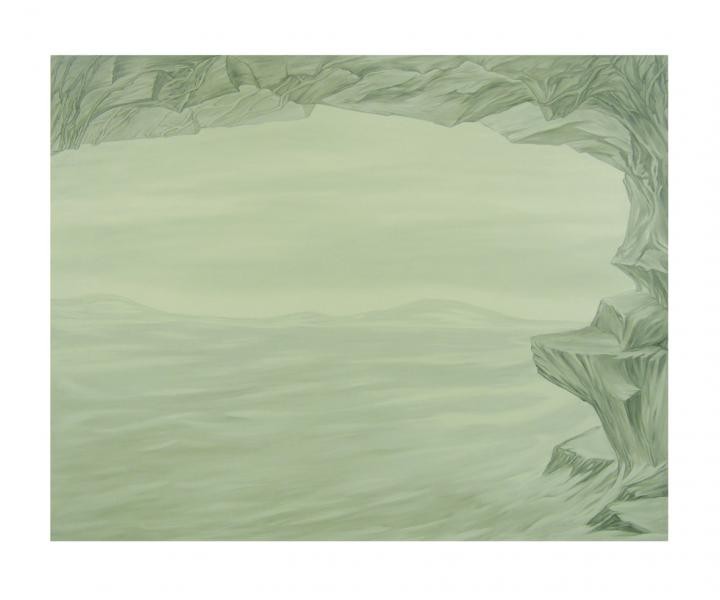Maria Serebriakova
10 Apr - 24 May 2014
MARIA SEREBRIAKOVA
East of Eden
10 April - 24 May 2014
The paintings of Maria Serebriakova, to the extent that they can be said to intentionally represent a given or known visual world, are as much about the nowhere and everywhere of her personal sensory experiences as a painter in the studio. Serebriakova has always been attracted to states of undefined psycho-phenomenological liminality, those interstitial spaces and transitional mental and emotional states that exist between what can be formally imagined, and what must eventually be posited as the substance of material reality.
That “threshold of appearance” marks a particular transitional awareness that is formally made evident by the opaque use of a singular soft lovat green paint application, something that adds to the sense of veiled transparency and in certain aspects also reinforces the interstitial space that often exists in Serebriakova’s art between drawing and painting.
This series of paintings undeniably deal in part with the dissolving and transitional nature of expressive forms in the visual and mental space that exists between drawing and painting in the extended mark making process.
They evoke in their overt people-less reality, not only a sense of withdrawn isolation but also inferences of abandonment—paradoxical states of imaginary appearance and disappearance. And while undoubtedly they have a direct association with landscapes, they are mental memories and personal assimilations transformed into imagined yet detached non-sentient locations.
What is undeniable, however, is that these new paintings by Maria Serebriakova, are images of transitional meaning and that they reflect upon her own personal and intensely private studio experiences with states of inwardness and emotional passage. Yet it remains the case that the viewer can never know the moment by moment mark making processes at work as the painter paints, and at the point of reception the viewer is left to infer and encapsulate their own sensory interpretations. This has been ever the case with this uniquely Russian artist who dwells in the borderlands of the imagination, the spaces in between, the interface that is at the periphery and the edge. She is an artist of increasing distillation, of reduction, of place and non-place, of anywhere and nowhere. Serebriakova’s paintings are always a challenge since they never possess a book of symbolic or narrative instructions. The viewer must be guided by their personal sense of aesthetic compass, and at the same time embrace the pre-signification of the Chora as an embodied threshold and living experience continuously at work in our world.
© Mark Gisbourne
East of Eden
10 April - 24 May 2014
The paintings of Maria Serebriakova, to the extent that they can be said to intentionally represent a given or known visual world, are as much about the nowhere and everywhere of her personal sensory experiences as a painter in the studio. Serebriakova has always been attracted to states of undefined psycho-phenomenological liminality, those interstitial spaces and transitional mental and emotional states that exist between what can be formally imagined, and what must eventually be posited as the substance of material reality.
That “threshold of appearance” marks a particular transitional awareness that is formally made evident by the opaque use of a singular soft lovat green paint application, something that adds to the sense of veiled transparency and in certain aspects also reinforces the interstitial space that often exists in Serebriakova’s art between drawing and painting.
This series of paintings undeniably deal in part with the dissolving and transitional nature of expressive forms in the visual and mental space that exists between drawing and painting in the extended mark making process.
They evoke in their overt people-less reality, not only a sense of withdrawn isolation but also inferences of abandonment—paradoxical states of imaginary appearance and disappearance. And while undoubtedly they have a direct association with landscapes, they are mental memories and personal assimilations transformed into imagined yet detached non-sentient locations.
What is undeniable, however, is that these new paintings by Maria Serebriakova, are images of transitional meaning and that they reflect upon her own personal and intensely private studio experiences with states of inwardness and emotional passage. Yet it remains the case that the viewer can never know the moment by moment mark making processes at work as the painter paints, and at the point of reception the viewer is left to infer and encapsulate their own sensory interpretations. This has been ever the case with this uniquely Russian artist who dwells in the borderlands of the imagination, the spaces in between, the interface that is at the periphery and the edge. She is an artist of increasing distillation, of reduction, of place and non-place, of anywhere and nowhere. Serebriakova’s paintings are always a challenge since they never possess a book of symbolic or narrative instructions. The viewer must be guided by their personal sense of aesthetic compass, and at the same time embrace the pre-signification of the Chora as an embodied threshold and living experience continuously at work in our world.
© Mark Gisbourne

